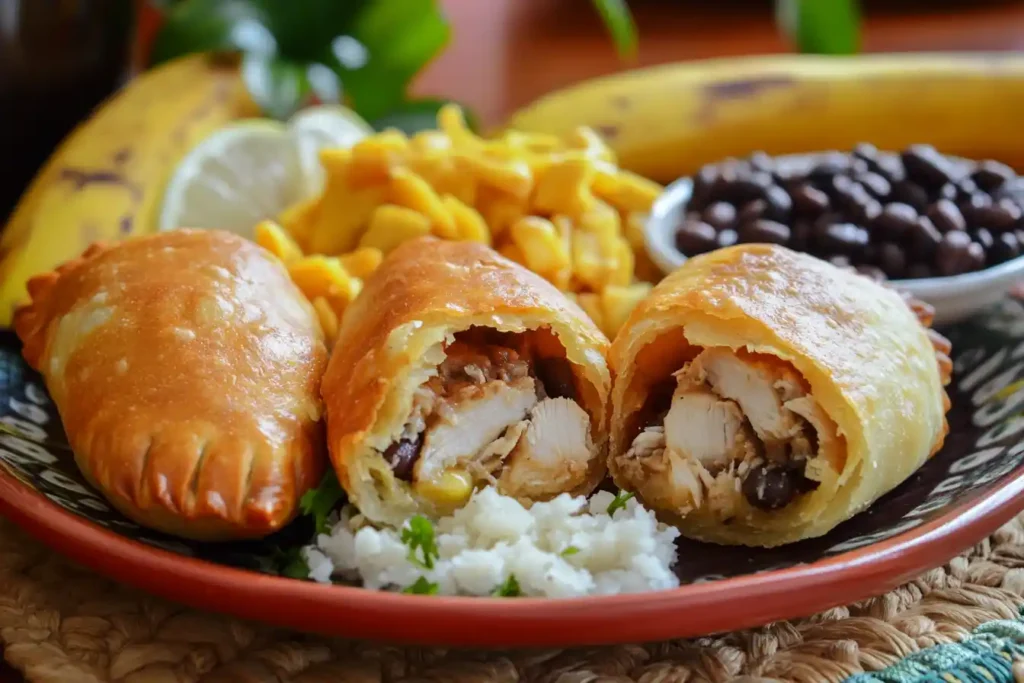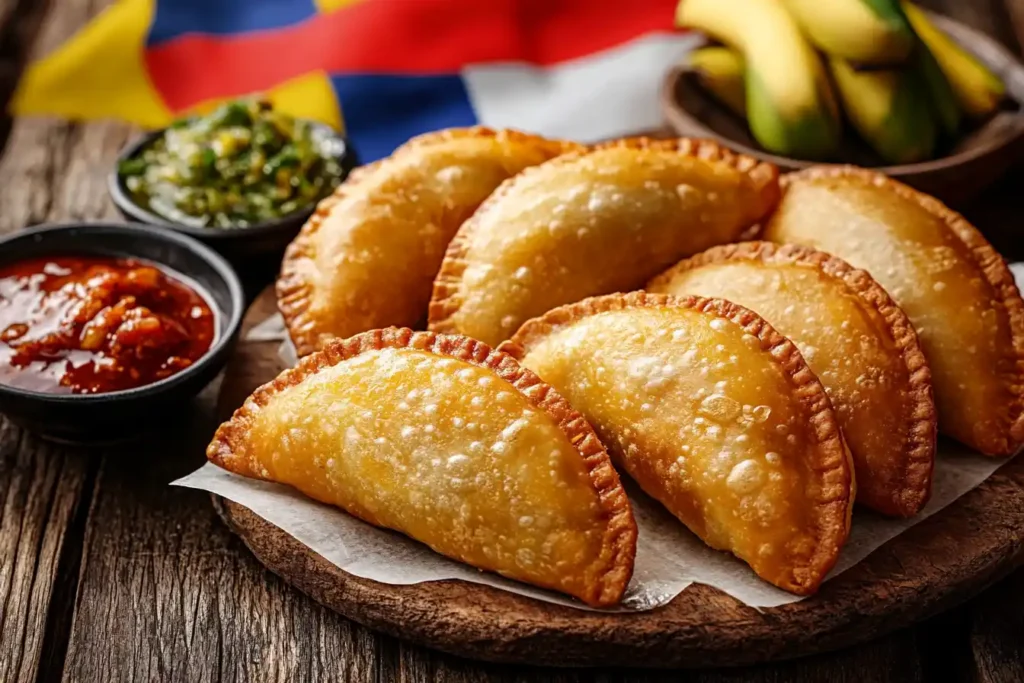Empanadas are a quintessential dish in Venezuela, a country known for its vibrant flavors and rich culinary traditions. These crescent-shaped delights are not just food—they’re a cultural icon. Unlike empanadas in other parts of the world, Venezuelans uniquely craft their empanadas with corn flour and fry them to golden perfection. In this article, we’ll explore what kind of empanadas are in Venezuela, their history, popular varieties, preparation techniques, and more.
Introduction to Venezuelan Empanadas
What Are Empanadas?
Empanadas are a type of stuffed pastry or turnover enjoyed across the globe. While their form and fillings vary depending on the region, the concept remains universal: a pocket of dough filled with savory or sweet ingredients. From the baked empanadas of Argentina to the fried varieties of the Caribbean, each culture has added its spin to this beloved dish.
The Unique Venezuelan Twist
In Venezuela, empanadas have a distinctive identity. Made with corn flour dough, these empanadas stand apart from their wheat-flour counterparts found in other countries. The dough is not just gluten-free but also carries a subtle sweetness that complements the savory fillings. Fried until golden brown, Venezuelan empanadas are crispy on the outside and soft on the inside—a textural delight.
They’re more than just a snack; people enjoy them as a staple food at breakfast, lunch, or even as a late-night indulgence. Whether filled with pabellón criollo (a combination of shredded beef, black beans, and plantains) or a simple slice of queso blanco (white cheese), Venezuelan empanadas capture the essence of the country’s diverse flavors.
The History of Venezuelan Empanadas
Origins of Empanadas in Venezuela
The story of Venezuelan empanadas is deeply rooted in the nation’s history and cultural diversity. Influenced by indigenous cooking traditions, the introduction of corn by pre-Columbian civilizations set the foundation for the dish. When European colonizers arrived, they brought along their own stuffed pastries, which combined with local ingredients to create a uniquely Venezuelan treat. African culinary traditions, introduced during the colonial period, also played a vital role in shaping the use of deep-frying techniques.
Venezuelan empanadas became a staple food due to their versatility and portability. They were perfect for laborers needing a quick, satisfying meal that could be eaten on the go.
Regional Variations in History
Different regions of Venezuela added their own spin to empanadas over time. Coastal areas leaned into seafood fillings, like cazón (dogfish), while the Andean regions often featured heartier ingredients like cheese and ground beef. These local adaptations have transformed empanadas into a mirror of Venezuela’s cultural and geographical diversity.
For more details about regional Venezuelan cuisine, visit this guide on Venezuelan empanadas.
Types of Venezuelan Empanadas
Popular Fillings

If you’re wondering what kind of empanadas are in Venezuela, the list of fillings alone will amaze you. Among the most beloved varieties are:
- Carne Molida (Ground Beef): A rich, seasoned meat filling perfect for meat lovers.
- Pollo Mechado (Shredded Chicken): Juicy chicken flavored with spices, ideal for a hearty bite.
- Queso Blanco (White Cheese): A simple yet satisfying option, with gooey melted cheese.
- Pabellón Criollo: A filling inspired by the national dish, combining shredded beef, black beans, and sweet plantains.
- Cazón (Dogfish): Popular in coastal areas, this fish-based filling offers a taste of the sea.
Specialty and Regional Varieties
Each Venezuelan region has its signature empanadas. In the Andean states, empanadas are often stuffed with combinations of meats and potatoes. Meanwhile, the Caribbean coast celebrates empanadas filled with fresh seafood and exotic spices. Modern interpretations have even embraced fusion flavors like ham and pineapple or vegetarian fillings.
Explore a comparison of Venezuelan and Colombian empanadas at this insightful link.
Cooking Techniques and Shapes
Unlike baked empanadas in other Latin American countries, Venezuelan empanadas are almost always fried. Their crescent shape is not just aesthetic—it’s functional, sealing in the delicious fillings while ensuring an even cook. Using corn flour for the dough provides a distinctive texture and flavor, making Venezuelan empanadas a standout in the world of stuffed pastries.
How Venezuelan Empanadas Are Made
Making the Dough

The foundation of Venezuelan empanadas lies in the dough, and it all starts with corn flour. Unlike the wheat-based dough used in many other empanada variations, Venezuelans rely on pre-cooked cornmeal, often branded as Masarepa. To make the dough, you’ll mix the cornmeal with water, salt, and a touch of oil until it reaches a smooth and pliable consistency.
Getting the right balance is crucial—too much water makes it sticky, and too little can cause cracking. The result should be soft enough to shape but firm enough to hold its filling. The corn flour gives the empanadas their signature flavor and gluten-free appeal.
Preparing the Fillings
Fillings are the soul of the empanada, and Venezuelans have mastered the art of variety. From shredded chicken to cheese and even cazón, the fillings are pre-cooked and well-seasoned. To prepare, sauté your chosen ingredients with onions, garlic, peppers, and spices until the flavors meld together.
For a unique Venezuelan touch, consider trying the pabellón criollo filling, a mix of shredded beef, black beans, and plantains. It’s an explosion of flavor that captures the essence of Venezuelan cuisine.
The Frying Process
Unlike some baked empanadas found elsewhere, Venezuelan empanadas are typically fried to a golden crisp. Heat oil in a deep pan or fryer, ensuring it’s hot enough to cook evenly but not too hot to burn the dough. Gently slide the empanadas into the oil, cooking each side until it’s perfectly golden. The frying seals the edges, ensuring the fillings stay intact while creating a crispy, irresistible crust.
Venezuelan Empanadas Compared to Other Empanadas
What Sets Venezuelan Empanadas Apart?
When comparing what kind of empanadas are in Venezuela to those from other countries, the corn flour dough is a defining feature. It gives the empanadas a distinctive texture and flavor that wheat dough simply can’t replicate. Additionally, the Venezuelan penchant for deep-frying ensures a crispy shell, setting them apart from the baked varieties often seen in Argentina or Chile.
Venezuelan empanadas are also celebrated for their wide array of fillings. The inclusion of seafood, like cazón, reflects the country’s coastal influence, while fillings like pabellón criollo showcase its rich culinary heritage.
Differences Across Latin America
While empanadas are popular across Latin America, each country brings its own twist. Argentinian empanadas often feature spiced beef and are baked rather than fried. Colombian empanadas share similarities with Venezuelan ones but are often smaller and include potatoes in the filling.
In contrast, Venezuelan empanadas are larger, with a thicker dough that crisps beautifully during frying. This makes them not just a snack but a satisfying meal.
Cultural Significance of Empanadas in Venezuela
Empanadas as Street Food
In Venezuela, empanadas are not just a dish—they’re a way of life. Strolling through any town or city, you’ll find street vendors frying fresh empanadas right before your eyes. These stalls, often accompanied by the aroma of sizzling oil and savory fillings, are a beloved part of daily life.
Empanadas are a go-to breakfast option, especially when paired with a strong cup of Venezuelan coffee. Workers, students, and tourists alike flock to these vendors for a quick, hearty, and affordable meal. The affordability and portability of empanadas make them a staple in the Venezuelan diet.
Empanadas in Festivities
Empanadas also play a starring role during celebrations and family gatherings. Whether it’s a birthday party, a national holiday, or simply a Sunday brunch, empanadas are often front and center on the menu. Families take pride in their recipes, passing them down through generations.
The versatility of fillings allows empanadas to cater to everyone’s taste, from vegetarians to seafood lovers. During festive seasons, it’s not uncommon to see empanadas filled with seasonal ingredients like ham or raisins, adding a special touch to the celebration.
FAQs About Venezuelan Empanadas
What Makes Venezuelan Empanadas Different?
Venezuelan empanadas are uniquely defined by their use of corn flour dough. This not only makes them gluten-free but also gives them a distinct texture—soft yet slightly crispy on the outside once fried. Unlike their baked counterparts found in Argentina, Venezuelan empanadas are almost always fried, creating a golden, crunchy crust that contrasts beautifully with the tender fillings inside.
The fillings themselves set Venezuelan empanadas apart. Classic options like pabellón criollo, a flavorful mix of shredded beef, plantains, and black beans, reflect the country’s rich culinary heritage. Even simpler varieties, such as cheese or ground beef, burst with flavor thanks to the spices and techniques used.
Does Venezuela Have Empanadas?
Yes, and they’re a vital part of the country’s cuisine. In fact, empanadas are among the most popular foods in Venezuela, enjoyed by people from all regions and walks of life. Street vendors sell them hot and fresh, while families prepare them at home for breakfast, lunch, or special occasions. Their versatility and cultural significance make them a national treasure.
For more insights on Venezuelan food traditions, you might enjoy exploring other Venezuelan staples like arepas and reina pepiada.
What Are the Different Types of Empanadas?
When it comes to answering what kind of empanadas are in Venezuela, the possibilities seem endless. Here are a few popular types:
- Cheese Empanadas: Filled with gooey queso blanco, these are simple yet satisfying.
- Ground Beef Empanadas: A savory option seasoned with garlic, onion, and peppers.
- Cazón Empanadas: A coastal favorite filled with spiced dogfish or shark.
- Pabellón Empanadas: Inspired by Venezuela’s national dish, featuring shredded beef, black beans, and sweet plantains.
- Vegetarian Empanadas: Filled with a mix of vegetables, beans, or plantains, perfect for non-meat eaters.
Regional influences also create exciting variations. In Andean areas, empanadas might include potatoes, while coastal recipes lean heavily on seafood.
What Is the Difference Between Argentinian and Venezuelan Empanadas?
At first glance, Argentinian and Venezuelan empanadas might look similar, but their differences are profound. Argentinian empanadas typically use wheat-based dough and are often baked, giving them a softer, bread-like texture. The fillings are also different—spiced ground beef or chicken is common, and raisins are sometimes added for a touch of sweetness.
On the other hand, Venezuelan empanadas stand out for their use of corn flour dough, which lends a distinctive flavor and texture. They are usually fried, creating a crispy outer shell that’s hard to resist. Their fillings also reflect Venezuela’s tropical and diverse culinary influences, incorporating ingredients like fish, plantains, and beans.
Conclusion and Call to Action
Summary of Venezuelan Empanadas
Venezuelan empanadas are a true reflection of the country’s culinary diversity and cultural richness. From their corn flour dough to the incredible variety of fillings, they stand apart from empanadas found in other parts of the world. Whether you’re indulging in a classic pabellón criollo empanada or savoring a seafood-filled cazón empanada, each bite tells a story of tradition and flavor.
So, what kind of empanadas are in Venezuela? The answer lies in their variety, from sweet and savory options to regional specialties that celebrate local ingredients. These crescent-shaped delights are more than just food—they’re a way to connect with Venezuela’s vibrant culture.
Encouragement to Try Making Empanadas
Ready to experience the magic of Venezuelan empanadas? Why not try making them at home? Start with a simple filling like queso blanco or ground beef, and once you’ve mastered the dough, experiment with more adventurous combinations. The process is as rewarding as the result, bringing a taste of Venezuela right to your kitchen.
Additional Tips and Recipes
Tips for Making Perfect Empanadas
To create authentic Venezuelan empanadas, start with high-quality corn flour, like Masarepa. Pay close attention to the consistency of your dough—it should be smooth and pliable but not sticky. When frying, ensure your oil is hot but not smoking, as this ensures a crispy crust without soaking up too much oil.
Another tip is to seal the edges of your empanadas well, either by pressing with a fork or pinching them together. This keeps the fillings intact while frying.
Where to Find More Recipes
If this article has inspired you to explore more Venezuelan cuisine, you’re in luck. Beyond empanadas, there’s an array of delightful dishes to try, such as arepas and reina pepiada. For more inspiration, browse the Venezuelan recipes featured on Magnetic Recipes.


3 thoughts on “What Kind of Empanadas Are in Venezuela? A Guide to Their Unique Flavors and Preparation”